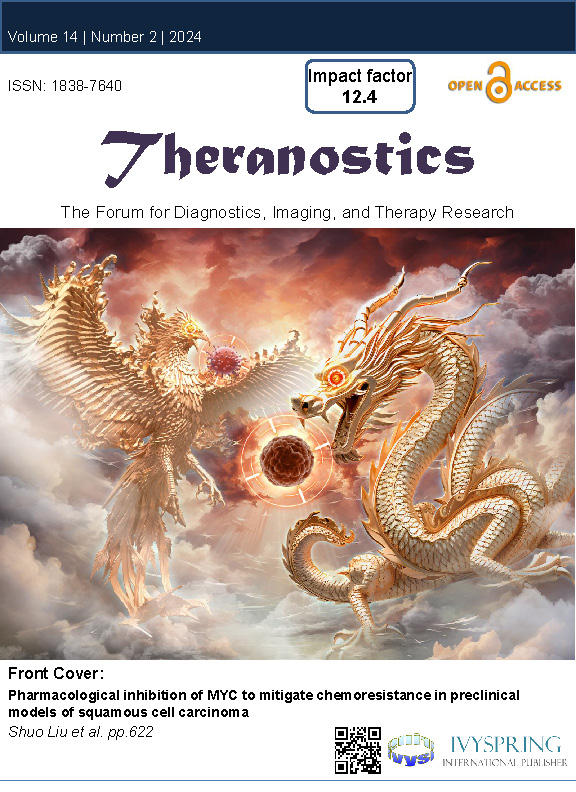基于细菌的级联原位近红外纳米光诱导光热肿瘤疗法
IF 12.4
1区 医学
Q1 MEDICINE, RESEARCH & EXPERIMENTAL
引用次数: 0
摘要
理论依据:光遗传工程兼性厌氧细菌具有在实体瘤部位定植的良好趋势和时空可编程的治疗药物释放能力,在肿瘤精准治疗方面受到广泛关注。然而,它们的疗效一般。传统的光热制剂具有很强的肿瘤消融能力,但其肿瘤靶向效率较低,会产生明显的脱靶副作用。光遗传学与光热疗法的结合可同时提供肿瘤靶向和出色的肿瘤消融能力,但遗憾的是,这种方法很少被研究。在此,我们构建了一种基于细菌的级联近红外光遗传-光热系统(EcNαHL-UCNPs),用于增强肿瘤治疗:EcNαHL-UCNPs由光遗传工程大肠杆菌Nissle 1917(EcN)与掺杂镧系元素的上转换纳米粒子(UCNPs)组成,后者能够在局部分泌α溶血素(αHL),这是一种孔形成蛋白,对近红外照射具有响应性。在 H22 和 4T1 肿瘤中测定了 EcNαHL-UCNPs 的抗肿瘤效果:αHL不仅能消灭肿瘤细胞,更重要的是能破坏内皮细胞,在肿瘤内形成血栓,是一种原位光热剂。原位形成的血栓在随后的近红外光照射下能显著增强 H22 肿瘤的光热消融作用。此外,在近红外光照射下,EcNαHL-UCNPs分泌的αHL不仅能抑制4T1肿瘤的生长,还能通过诱导免疫反应抑制4T1肿瘤的转移:我们的研究强调了基于细菌的级联光遗传-光热系统对肿瘤的精确有效治疗。本文章由计算机程序翻译,如有差异,请以英文原文为准。
Bacteria-based cascade in situ near-infrared nano-optogenetically induced photothermal tumor therapy
Rationale: Optogenetically engineered facultative anaerobic bacteria exhibit a favorable tendency to colonize at solid tumor sites and spatiotemporally-programmable therapeutics release abilities, attracting extensive attention in precision tumor therapy. However, their therapeutic efficacy is moderate. Conventional photothermal agents with high tumor ablation capabilities exhibit low tumor targeting efficiency, resulting in significant off-target side effects. The combination of optogenetics and photothermal therapy may offer both tumor-targeting and excellent tumor-elimination capabilities, which unfortunately has rarely been investigated. Herein, we construct a bacteria-based cascade near-infrared optogentical-photothermal system (EcNαHL-UCNPs) for enhanced tumor therapy./nMethods: EcNαHL-UCNPs consists of an optogenetically engineered Escherichia coli Nissle 1917 (EcN) conjugated with lanthanide-doped upconversion nanoparticles (UCNPs), which are capable of locally secreting α-hemolysin (αHL), a pore-forming protein, in responsive to NIR irradiation. Anti-tumor effects of EcNαHL-UCNPs were determined in both H22 and 4T1 tumors./nResults: The αHL not only eliminates tumor cells, but more importantly disrupts endothelium to form thrombosis as an in situ photothermal agent in tumors. The in situ formed thrombosis significantly potentiates the photothermic ablation of H22 tumors upon subsequent NIR light irradiation. Besides, αHL secreted by EcNαHL-UCNPs under NIR light irradiation not only inhibits 4T1 tumor growth, but also suppresses metastasis of 4T1 tumor via inducing the immune response./nConclusion: Our studies highlight bacteria-based cascade optogenetical-photothermal system for precise and effective tumor therapy.
求助全文
通过发布文献求助,成功后即可免费获取论文全文。
去求助
来源期刊

Theranostics
MEDICINE, RESEARCH & EXPERIMENTAL-
CiteScore
25.40
自引率
1.60%
发文量
433
审稿时长
1 months
期刊介绍:
Theranostics serves as a pivotal platform for the exchange of clinical and scientific insights within the diagnostic and therapeutic molecular and nanomedicine community, along with allied professions engaged in integrating molecular imaging and therapy. As a multidisciplinary journal, Theranostics showcases innovative research articles spanning fields such as in vitro diagnostics and prognostics, in vivo molecular imaging, molecular therapeutics, image-guided therapy, biosensor technology, nanobiosensors, bioelectronics, system biology, translational medicine, point-of-care applications, and personalized medicine. Encouraging a broad spectrum of biomedical research with potential theranostic applications, the journal rigorously peer-reviews primary research, alongside publishing reviews, news, and commentary that aim to bridge the gap between the laboratory, clinic, and biotechnology industries.
 求助内容:
求助内容: 应助结果提醒方式:
应助结果提醒方式:


